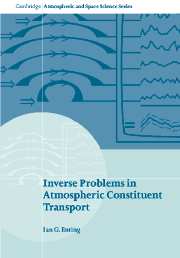Book contents
- Frontmatter
- Contents
- Preface
- Part A Principles
- Chapter 1 Introduction
- Chapter 2 Atmospheric transport and transport models
- Chapter 3 Estimation
- Chapter 4 Time-series estimation
- Chapter 5 Observations of atmospheric composition
- Chapter 6 The sources and sinks
- Chapter 7 Problem formulation
- Chapter 8 Ill-conditioning
- Chapter 9 Analysis of model error
- Chapter 10 Green's functions and synthesis inversion
- Chapter 11 Time-stepping inversions
- Chapter 12 Non-linear inversion techniques
- Chapter 13 Experimental design
- Part B Recent applications
- Appendices
- Solutions to exercises
- References
- Index
Chapter 10 - Green's functions and synthesis inversion
Published online by Cambridge University Press: 05 November 2009
- Frontmatter
- Contents
- Preface
- Part A Principles
- Chapter 1 Introduction
- Chapter 2 Atmospheric transport and transport models
- Chapter 3 Estimation
- Chapter 4 Time-series estimation
- Chapter 5 Observations of atmospheric composition
- Chapter 6 The sources and sinks
- Chapter 7 Problem formulation
- Chapter 8 Ill-conditioning
- Chapter 9 Analysis of model error
- Chapter 10 Green's functions and synthesis inversion
- Chapter 11 Time-stepping inversions
- Chapter 12 Non-linear inversion techniques
- Chapter 13 Experimental design
- Part B Recent applications
- Appendices
- Solutions to exercises
- References
- Index
Summary
Such schemes have much to recommend them, particularly when they work (usually meaning that the modeler likes the results)…
Carl Wunsch: The Ocean Circulation Inverse Problem.Green's functions
Much of the discussion in this book has simply assumed the validity of a linear relation between sources and concentrations, at least in a discretised form. This section aims to clarify the origin and significance of this ‘Green-function’ representation.
The approach follows the ideas introduced in Chapter 2: the process of modelling is regarded as going from the real world to a mathematical model and then to a computer implementation of the model. A sequence of mathematical representations of the transport equations is presented in this chapter, working backwards from those closest to numerical implementations of transport. This is followed by analyses of the representation of transport as sets of ordinary differential equations (ODEs) and partial differential equations (PDEs). This explicit consideration of the mathematical model is useful in establishing general characteristics of the solutions that are less apparent in the computer implementation.
The Green functions used in atmospheric-transport modelling represent specific cases of the general principle that an inhomogeneous linear differential equation (DE) with specified boundary conditions can be ‘solved’ by constructing an integral operator that is the inverse of the differential operator. The Green function is the kernel of this integral operator. An important property of this relation is that any particular Green-function solution is equivalent to the solution of the DE only for a specific set of boundary conditions.
- Type
- Chapter
- Information
- Inverse Problems in Atmospheric Constituent Transport , pp. 163 - 191Publisher: Cambridge University PressPrint publication year: 2002

